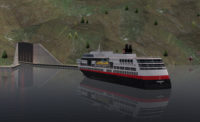To build a $3.4-billion underground high-speed railroad into Oslo, Norwegian engineers left their comfort zone of drill-blast rock excavation in favor of tunnel-boring machines. Hard, abrasive rock and more water than expected only hindered the project minimally; however, it fell victim to the weak finances of a main contractor.
A pair of hard-rock TBMs heading toward Oslo broke through their parallel drives side by side in September 2018, five months ahead of schedule, says Anne Kathrine Kalager, project manager on the bored sections with the state railroad infrastructure manager, Bane NOR. A second, southbound pair broke through in February.
But a corporate failure in the north section delayed the project’s final holing through by months. Now running about a year behind schedule and 8% over budget, the project had been in good shape until the contractor drill-blasting the north stretch of caverns and tunnels went into court protection at home in Italy, says Bane NOR’s project director, Per David Borenstein.
The 22-kilometer project will deliver a high-speed railroad from Oslo to Ski, augmenting the existing, slow Østfold line. From Oslo central station, the Follo tracks will run southwards through a 600-meter-long cut-and-cover tunnel before entering a 170-m-long rock cavern. They will continue southwards in drill-and-blast tunnels for about 1.5 km before entering around 18 km of twin tunnels driven by four 9.9-m-dia TBMs, surfacing near Ski. Set some 20 m apart, the tunnels are linked every 0.5 km with cross passages.
“Everyone is a formula one driver at heart.”
– Matteo Ortu, Project Manager with Acciona/Ghella JV
After reviewing European practices, Bane NOR’s team saw that “in all long tunnels designed for high-speed and high-frequencies trains, they had chosen the concept of twin single-track tunnels with cross connections,” says Kalager.
Having decided on twin single bores instead of a wide twin-track tunnel in 2010, Bane NOR again broke with tradition by choosing TBMs, rather than drill-and-blast, for environmental reasons, says Kalager. Instead of the seven access sites needed for D&B, a single location at Åsland, halfway along the route and close to the E6 highway, served the TBMs.
Since hard-rock tunnel TBMs had fallen out of favor in Norway, Bane NOR sought expertise from veterans of previous hydro projects. “We got in touch with a number of people. … They were in charge of making the specification for the TBMs,” say Kalager.
No TBM tunnels had been built in Norway in the 20 years before 2013, according to Amund Bruland, a civil engineering professor at the Norwegian University of Science and Technology, Trondheim.
And no railroad tunnels were built with TBMs until Bane NOR’s predecessor started the 7.7-km-long Ulriken twin drives into Bergen, where a 9.3-m-dia Herrenknecht Gripper broke through two years ago.
For the Follo tunnel contract, bidders were required to use double-shield TBMs because “we wanted (them) to focus only on one excavation method,” says Kalager. Bane NOR’s specification was “pretty much detailed,” adds Matteo Ortu, then project manager with the bored tunnel’s Spanish-Italian joint venture of Acciona Infraestructuras S.A. and Ghella S.p.A. (AGJV).
Kalager remembers scepticism in the supply chain about the size and weight of the TBMs. “Our experienced veterans told them, ‘You are going to fight against the hardest rock you have ever fought against,’ ” she says. With axial strengths of 150-300 megapascals, the generally abrasive gneiss rock along the tunnel includes bands of amphibolite and pegmatite. They also contain clay-filled valleys above known fracture zones.
In such hard rock, “a lot of people were afraid the cutter head would not be able to complete the project,” says Matthias Flora, product manager for hard-rock tunneling at the TBM’s supplier, Herrenknecht A.G., based in Schwanau, Germany.
Weighing 265 tonnes, the cutter heads were about 25% heavier than those the company is supplying for work on the weaker Brenner tunnel rock between Italy and Switzerland, he says.
Bane NOR specified double-shield TBMs for maximum speed while protecting workers from rock falls by either the shield or following lining, says Kalager. By excavating the face while erecting the lining at the same time, such TBMs can be 30% faster than single- shield machines, says Flora.
In March 2016, AGJV won the TBM engineering, procurement and construction contract with the highest total technical and commercial evaluation score, though its $1 billion price was not the lowest, says Kalager. One of AGJV’s first jobs was to excavated two large TBM launch caverns nearly 400 m apart along the tunnel route at Åsland.
The first TBM set off from Åsland in September 2016, followed some five weeks later by the second. They broke through simultaneously into the separate ends of drill-blast tunnels near Oslo central station last September.
The southbound TBMs began in November and December 2016, breaking through together into the open air late this February. “Healthy competition” between the parallel TBM crews probably boosted progress, says Ortu. “Everyone is a Formula One driver at heart,” he adds.
The Follo tunnels are made permanently watertight by the segmental lining erected immediately behind the rear shield and grouted to fill voids in surrounding rock. But additional precautions were also needed. Because rock along the tunnel was known to contain clay-filled valleys above fracture zones, the TBMs were equipped to drill and grout 35 m ahead of the face. Otherwise, water draining from the clay, via the fracture zones, would cause pore pressure drops in the clay, resulting in surface ground settlement under built up areas, says Kalager.
The contract forecast 1,600 m of total pre-grouting, with provisions for time and budget compensation for more difficult conditions. “We did about 7,640 m,” says Fabio Moizo, AGJV’s technical manager. “In general, when water was not encountered, (the TBMs) performed very well,” he says.
Covering excavation, track and other systems except signaling, AGJV’s lump-sum contract includes a schedule of milestones. Falling behind schedule triggers penalties, says Ortu. However, “the contractor is protected in case the rock is harder and more demanding,” he adds.
“Rock conditions encountered along the tunnel drives were resulting in lower penetration rates and higher cutter consumption,” says Ortu.
In the contract, Bane NOR provided an assumed baseline of rock and machine parameters. Predicted excavation rates were calculated at 16.22 m per day for the north tunnels and 15.86 m for the south, says Moizo. Real advance rates averaged 15 m per day northwards and 13.7 m in the south tunnels, he adds.
However, Bane NOR and the joint venture have yet to agree on an assessment of the actual geology, says Moizo. A four-month contract extension from the original April 2021 completion was caused by outside influences, says Kalager.
Back to Basics
While TBMs suited the Follo line’s long straight drives, near Oslo the excavations were more traditional. The 600-m-long cut-and-cover section near the central station leads to a drill-and-blast cavern 170 m long to contain both Follo line tracks and one track of the existing Østfold line. The cavern size varies, reaching up to 32 m wide and 15 m high.
In a few sections, where the excavations passed slightly below large petroleum-storage caverns and the E6 highway tunnel, Bane NOR specified a drill-and- split approach, to avoid explosives. Instead, crews drilled up to 500 narrow holes 1.5-m long into the roughly 70-sq-m rock face.
Hydraulic wedges expanded in the holes split the rock with little vibration. It was slow work, advancing about 0.5 m a day, says Kalager. Altogether, 185 m of tunneling in the northern section was by drill and split while nearly 2.6 km involved blasting.
The 1.5 km set of twin tunnels from the cavern close to the station are also drill-and-blast, though Bane NOR had considered using TBMs. But because of nearby sensitive infrastructure, “it would not have been recommended to speed up in that area if the TBMs had been delayed,” says Kalager.
To keep the last section of twin tunnels off the project’s critical path, Bane NOR incorporated that work in an ill-fated drill-and-blast contract, setting it on a course to delay. Bane NOR procured all the drill-and-blast work and the cut-and-cover section in two EPC contracts worth $400 million, won by Società Italiana per Condotte d’Acqua S.p.A in 2015. In early 2018, the contracts were terminated with about half the required work completed, says Borenstein.
“The contractor had financial issues … they didn’t have the money to pay the subcontractors [in Oslo],” says Borenstein. “So we divided the remaining work into four contracts and went out to the [local] market. It’s worked very well,” he says.
With the final contracts awarded last October, the project missed a six-week possession of existing tracks that it would otherwise have had for work needed last summer, says Borenstein. Preparations for systems installation are now taking over. And while the financial woes of one contractor pushed back the whole project’s opening to December 2022, Kalager says neither the hard rock nor the face pre-grouting were “show-stoppers for using TBMs.”











Post a comment to this article
Report Abusive Comment